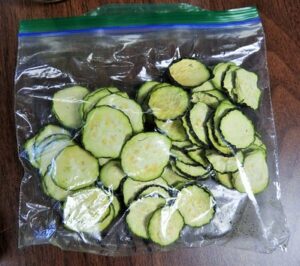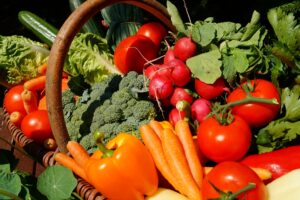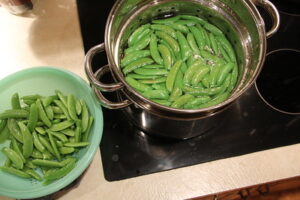 If you’re a gardener or have shopped a local farmer’s market recently, you know that there is an abundance of produce currently in season. And while the most delicious preparation of fruits and vegetables can require the least amount of alteration (tomato sandwich, anyone?), preserving some of the seasonal bounty is a wonderful option to transform a cold winters day which a nibble of something you preserved from the peak of summer. While some people might first think of canning as the best way to preserve seasonal produce, another easy and delicious method is dehydrating it. Why not give it a try?
If you’re a gardener or have shopped a local farmer’s market recently, you know that there is an abundance of produce currently in season. And while the most delicious preparation of fruits and vegetables can require the least amount of alteration (tomato sandwich, anyone?), preserving some of the seasonal bounty is a wonderful option to transform a cold winters day which a nibble of something you preserved from the peak of summer. While some people might first think of canning as the best way to preserve seasonal produce, another easy and delicious method is dehydrating it. Why not give it a try?
Selecting a Dehydrator
 You’ll need minimal equipment for dehydrating. An electric food dehydrator is a good option for home food dehydrating because you will have the most control over how the product dries which will lend to the best final product quality. Dehydrators should have an adjustable thermostat and a fan that blows warm air over the food. Food should be pretreated, cut into uniform sizes and spread out evenly over the trays without overlapping or crowding. Remember to rotate trays throughout drying for consistency. When produce is done drying, make sure to do a dryness test before storage.
You’ll need minimal equipment for dehydrating. An electric food dehydrator is a good option for home food dehydrating because you will have the most control over how the product dries which will lend to the best final product quality. Dehydrators should have an adjustable thermostat and a fan that blows warm air over the food. Food should be pretreated, cut into uniform sizes and spread out evenly over the trays without overlapping or crowding. Remember to rotate trays throughout drying for consistency. When produce is done drying, make sure to do a dryness test before storage.
Produce Selection
 To get the best overall dehydrated product, there are several considerations to keep in mind. First, you’ll want to select produce at its peak flavor and quality. Under-ripe or overripe produce can lack flavor and color or can be tough and fibrous or soft and mushy. Next, consider which pretreatment you’ll need to use. Pretreating produce before drying is recommended because it prevents darkening, helps maintain flavor and texture and can also inhibit the growth of potentially harmful bacteria during drying.
To get the best overall dehydrated product, there are several considerations to keep in mind. First, you’ll want to select produce at its peak flavor and quality. Under-ripe or overripe produce can lack flavor and color or can be tough and fibrous or soft and mushy. Next, consider which pretreatment you’ll need to use. Pretreating produce before drying is recommended because it prevents darkening, helps maintain flavor and texture and can also inhibit the growth of potentially harmful bacteria during drying.
Pretreatment
There are two main methods of pretreatment when dehydrating; an acidic solution dip for fruits (which are considered high acid) and blanching for vegetables (low acid foods).
To pretreat fruit
- Wash and cut to a uniform desired size.
- Dip them in an ascorbic acid, citric acid, or lemon juice solution.
- Drain with colander and blot dry before placing on food dehydrator.
To blanch vegetables
- Fill a pot half full of water and bring to a boil.
- Submerge prepared vegetables in boiling water
- Bring water back to a boil and start the timer for the recommended amount of time
- Remove blanched vegetables and place them in an ice water bath to cool.
- Drain with colander and blot dry before placing on food dehydrator.
Keep in mind that different fruits and vegetables have optimal drying times as well as dryness indicators. Refer to the CSU Fact Sheets 9.308 Drying Vegetables and 9.309 Drying Fruit for a list of recommendations and timing for pretreatments and drying for a variety of fruits and vegetables.
Storage of Dried Goods
 When the dried and cooled vegetables are ready for storage, pack them in small amounts in clean glass jars or in moisture and vapor proof freezer containers or bags. Label containers with the name of the product and date. Store in a cool, dry, dark place. When properly dried and stored, vegetables will keep well for six to twelve months. Enjoy them in a variety of ways to add flavor and interest to your pantry options such as:
When the dried and cooled vegetables are ready for storage, pack them in small amounts in clean glass jars or in moisture and vapor proof freezer containers or bags. Label containers with the name of the product and date. Store in a cool, dry, dark place. When properly dried and stored, vegetables will keep well for six to twelve months. Enjoy them in a variety of ways to add flavor and interest to your pantry options such as:
- Soups and stews
- Casseroles
- Baked goods
- Snacks on the go
- Vegetable flakes & powders for seasoning
- Camping and backpacking trips
![]() Happy dehydrating! For more food preservation information developed by Colorado State University Extension, please visit https://apps.chhs.colostate.edu/preservesmart/ or download Preserve Smart on your mobile device.
Happy dehydrating! For more food preservation information developed by Colorado State University Extension, please visit https://apps.chhs.colostate.edu/preservesmart/ or download Preserve Smart on your mobile device.

